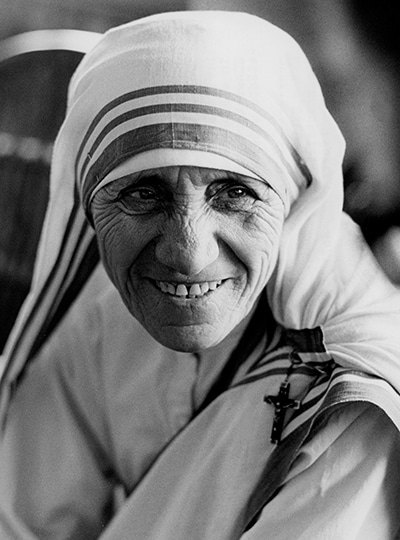When I first met Mother Teresa on the airport tarmac in Atlanta on June 12, 1995, I could never have imagined that she would alter my life forever. I was in a crucible, weighed down by sorrow after the loss of my husband to cancer and living day by day, without purpose or meaning in my life. The extent of my faith-based life was covering events for the Archdiocese of Atlanta.
However, my interior emptiness was becoming evident in all aspects of my life. It all changed in a flash in the instant when Mother Teresa held my hands on that misty, gray day in Atlanta and, looking deeply into my eyes, invited me to “Come and see.”
It was the calling I had been waiting for my entire life, and I said, “Yes.” It would take another decade before I would fully embrace the Catholic faith as my own, and it was during the beatification of Mother Teresa in St. Peter’s Square on Oct. 19, 2003, when I had the calling to join the Church — not as a journalist, but as a person led to participate in her sacraments.
Seeing Jesus

When I recall the instant when Mother Teresa embraced my hands over 25 years ago, it was as if I was being touched by Jesus himself. My mind went completely blank, and as I stared into her eyes, I felt transported into a place of unconditional love and acceptance. That sensory experience lasted with me the entire day. It was evident to me then that Mother Teresa would become the very person to lead me and thousands of others to our discernment of the Catholic faith.
One might consider that auspicious meeting in Atlanta as a synchronistic experience, but in my mind, I have always considered it a miraculous encounter, designed to bring me out of the darkness of my existence and onto the spiritual path. I recognized in Mother Teresa the perfect vehicle to bridge my love of the poor through my documentary work and translating it into actually seeing Jesus in the beggar, the dying and abandoned children. Mother Teresa once led Bishop William Curlin of Charlotte, North Carolina, onto the streets of Calcutta after asking him if he wanted to meet Jesus. When they came upon a dying man, Mother Teresa knelt on the ground and embraced him in her arms and said, “This is Jesus.”
Calcutta
When I arrived in Calcutta, India, in August 1995, I had no idea what to expect. Mother Teresa greeted me in the hallway of the motherhouse, and, at first, denied me permission to document the work at the homes established in the sprawling city. Instead, she sent me to volunteer at Shishu Bhavan, the children’s home near the headquarters of the Missionaries of Charity.
Each morning, I attended Mass in the spartan chapel. Mother Teresa was hardly visible, curled up on a straw mat, deep in prayer. After Mass, she would often greet visitors on a worn wooden bench in the hallway.
It was here, after several more requests, that she finally gave me written permission to photograph in the homes. When she handed me that sliver of pink paper with her handwritten note, giving me access to the work she established in the 1950s, I felt overwhelmed with gratitude and acceptance.
Special request
That November, I had an unexpected request from the Missionaries of Charity sisters — to photograph the profession of vows of a group of sisters making their first vows to the order. Everything that could have gone wrong that day did. One of my cameras stopped functioning, and my battery pack for my flash died. I went on a hunt for an electric shop near the infamous Howrah railroad station in the heart of Calcutta.
Then, I recalled Mother Teresa suggesting that I pray. So I stood on a street corner and prayed to God for assistance. It was an unfamiliar practice for me. Almost immediately, I found a small shop, and after requesting assistance, a salesman changed some of the wires in the battery, and the light switched on. I gasped with surprise. I hailed a taxi and just made it on time to St. Mary’s Catholic Church, located near the motherhouse.
Mother figure
This is where I saw Mother Teresa being the epitome of the mother figure. A lineup of sisters was gathered outside the entrance of the church, their handwritten vows clutched in their hands. Mother Teresa hovered around the group, and it was evident they basked in her attentiveness.
Msgr. John Esseff of Scranton, Pennsylvania, a confessor for Mother Teresa, told me, “The sisters are her daughters, and they are central to her mission.”
The evening sun bathed an ethereal light over the group as they were led slowly into the sanctuary. This is where I also felt the full impact of how a tiny nun was able to change the world through her iconic message of alleviating the suffering of the poor.
In 2015, I would attend a profession of vows Mass in the same church, this time without Mother Teresa in attendance. I sat with Sister Tarcisia, the 18th sister to join the order. Tears rolled down my face during the entire ceremony, and once again, I thanked Mother Teresa silently in prayer for changing the course of my life.

The moment Pope Francis declared Mother Teresa would be canonized as a saint in the Church, I booked my airline ticket to Rome. At the time, I was teaching at a woman’s private university in Saudi Arabia. I took an unpaid leave from my teaching duties to attend the canonization. It was a scorching hot day on Sept. 4, 2016. I was one of the first in line at 4:30 a.m. The gates opened to St. Peter’s Square as the sun was rising over the cathedral.
One of my first thoughts was that, at one time, I could sit alone with Mother Teresa on that wooden bench and speak to her directly. Now, I had to share her with the world, and I could best do that by continuing my documentary work on her legacy that continues to inspire millions in their life of faith.
When the order of the Missionaries of Charity was founded in 1950, Mother Teresa consecrated the order to Mother Mary, and her single-minded focus was on satiating the thirst of Jesus on the cross for souls. Her invitation to participate in the work spanned over 136 countries and countless homes. It is almost impossible for those of us who encountered her presence to not speak of her without tears. Through a synchronistic chain of events, we were all a part of something bigger than words can convey.
Linda Schaefer is an author and photographer who wrote “Encountering Mother Teresa” (OSV, $39.95).







